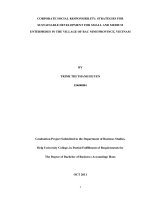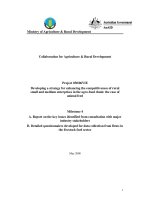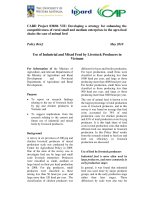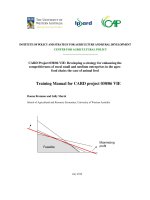factors affecting the adoption of e-commerce model developed for small and medium enterprises in viet nam
Bạn đang xem bản rút gọn của tài liệu. Xem và tải ngay bản đầy đủ của tài liệu tại đây (1.69 MB, 80 trang )
Thai Nguyen University
Southern Luzon State University
Socialist Republic of Vietnam
Republic of Philippines
FACTORS AFFECTING THE ADOPTION OF E-COMMERCE MODEL
DEVELOPED FOR SMALL AND MEDIUM ENTERPRISES IN viet nam
A Dissertation
Presented to the Faculty of Graduate School
Southern Luzon State University, The Philippines and
Thai Nguyen University, Socialist Republic of Vietnam
In Partial Fulfillment
of the Requirements for the Degree
Doctor in Management
By
NGUYEN TIEN HUNG - FAT
SLSU-DBA 6A (Hanoi)
May 2013
Abstract
E-commerce can be an important source of competitive advantage for most
business
organizations,
especially small and medium enterprise sized
(SMEs).
This study examines the factors that influence e-commerce adoption in Vietnam
SMEs .
By studying the ecommerce model advantage and SMES‟ Readiness to Adopt,
this study proposed and validated a predictive model.
Developed from the
technology
acceptance
model and other relevant
researches in the area, the author identified six factors that influence electronic
commerce adoption in VietNam as follows: Capacity of the firm to start e-commerce
adoption; compatibility of e-commerce to the value, work practices, and technology at
the firm; influence of managers on e-commerce adoption; effect of the ease of use on
e-commerce adoption; effect of the usefulness on e-commerce adoption; and effect of
effectiveness on e-commerce adoption.
To validate the research model, 200 questionnaires were collected from 200
SMEs in HaNoi.
i
TABLE OF CONTENTS
CHAPTER 1:1 INTRODUCTION .............................................................................................. 1
1.1. Background of the Study ........................................................................................ 2
1.2. Statement of the Problems ...................................................................................... 5
1.3. Significance of the Study ........................................................................................ 5
1.4. Scope and Limitation .............................................................................................. 6
CHAPTER II: 7 REVIEW OF RELATED LITERATURE...................................................... 7
2.1. Internet .................................................................................................................... 7
2.2. E-commerce ............................................................................................................ 9
2.3. E-Commerce Models. .......................................................................................... 12
2.4. Theory of Reasoned Action (TRA)....................................................................... 16
2.5. Technology Acceptance Model ............................................................................ 18
2.6. Grandon and Perason's Model .............................................................................. 20
2.7. Innovations Diffusion Theory (IDT) .................................................................... 23
2.8. Model of Factors Influencing Electronic Commerce Adoption and Diffusion in
Small- & Medium-sized Enterprises ............................................................................ 27
2.9. Model for Assessing E-commerce Success in SMEs ........................................... 29
2.10. Conceptual Framework ....................................................................................... 33
CHAPTER III: 38RESEARCH METHODOLOGY ............................................................... 38
3.1. Research Design.................................................................................................... 38
3.2. Determination of sample size................................................................................ 38
3.3. Sampling design and techniques ........................................................................... 39
3.4. Research instrument .............................................................................................. 39
3.5. Data processing method ........................................................................................ 40
ii
CHAPTER IV:41 PRESENTATION, ANALYSIS AND INTERPRETATION OF
RESULTS ..................................................................................................................................... 41
4.1. Respondents‟ profile ............................................................................................. 41
4.2. Factors afecting the adoption of e-commerce ....................................................... 45
4.3. Logistic Regression ............................................................................................... 55
CHAPTER V: 66SUMMARY, CONCLUSIONS AND RECOMMENDATIONS............ 66
5.1. Summary of the findings ....................................................................................... 66
5.2. Conclusion ............................................................................................................ 68
5.3. Recommendations ................................................................................................. 70
REFERENCES ............................................................................................................ 71
QUESTIONNAIRE ..................................................................................................... 73
iii
LIST OF TABLES
Table 4.1: Descriptive analysis of the respondents ..........................................................
Table 4.2: Business areas .................................................................................................
Table 4.3: Firms utilizing e-commerce and firms having a website Crosstabulation ......
Table 4.4: KMO and Bartlett's Test .................................................................................
Table 4.5: Rotated Component Matrix ............................................................................
Table 4.6: KMO and Bartlett's Test .................................................................................
Table 4.7: Rotated Component Matrix ............................................................................
Table 4.8: Reliability Statistics ........................................................................................
Table 4.9: Item-Total Statistics ........................................................................................
Table 4.10: Reliability Statistics ......................................................................................
Table 4.11: Item-Total Statistics ......................................................................................
Table 4.12: Reliability Statistics ......................................................................................
Table 4.8: Reliability Statistics ........................................................................................
Table 4.9: Item-Total Statistics ........................................................................................
Table 4.10: Reliability Statistics ......................................................................................
Table 4.11: Item-Total Statistics ......................................................................................
Table 4.12: Reliability Statistics ......................................................................................
Table 4.13: Item-Total Statistics ......................................................................................
Table 4.14: Reliability Statistics ......................................................................................
Table 4.15: Item-Total Statistics ......................................................................................
Table 4.16: Reliability Statistics ......................................................................................
Table 4.17: Item-Total Statistics ......................................................................................
Table 4.18: Omnibus Tests of Model Coefficients ..........................................................
iv
Table 4.19: Model Summary ...........................................................................................
Table 4.20: Classification Table
v
LIST OF FIGURE
Figure 2.1: Internet model................................................................................................
Figure 2.2: B2B Business Model .....................................................................................
Figure 2.3: B2C Business Model .....................................................................................
Figure 2.4: C2C Business Model .....................................................................................
Figure 2.5: C2B Business Model .....................................................................................
Figure 2.6: Schematics of the theory of reasoned action (TRA) .....................................
Figure 2.7: Acceptance Model TAM (Davis 1989) .........................................................
Figure 2.8: Research model (Grandon and Pearson, 2004) .............................................
Figure 2.9: The common characteristics of IT innovation that influence intended ........
Figure 2.10: Proposed Electronic Commerce Adoption Model for Small- and
Medium-sized Enterprises ...............................................................................................
Figure 2.11: Proposed model for assessing e-commerce success in SMEs .....................
Figure 2.12: Research model ...........................................................................................
Figure 4.1 Business areas .................................................................................................
Figure 4.2 Business areas and firm utilize e-commerce ..................................................
Figure 4.3: Number of the firms have internet ................................................................
Figure 4.4:Research model after factor analysis .............................................................
vi
CHAPTER 1
INTRODUCTION
For recent decades, Information technology (IT) has been changing the world by
significantly contributing to fasten the globalization process in which all competitors
come to have equal opportunities in a flattened world as well as creating a real
revolution in every field of science and life.
The application of IT in production and business is not out of this trend either.
The concept of IT application in commercial activities, also known as e-commerce,
came into the world and become a new trend. E-commerce has been gradually
replacing the old ways of doing business because of its variousprominent advantages,
such as faster buying/selling procedure, lowered operational costs , more convenience
for customers to place orders, increased efficiency with unlimited space and time
properties, etc.
However, for developing countries in general and for Vietnam in particular, ecommerce is a relatively new thing although the development of this trend have been
taking place in both width and depth. It has not actually been completed for this area
in State management. The application in the enterprises as well as in the agencies and
organizations is also at explorative level, to support the traditional business form or to
combine these two forms with each other.
In fact, many enterprises have applied and developed e-commerce and some of
them have become good models in this area such as VIETGO, a pricing joint stock
company with e-commerce page www.vatgia.com; and Peaceoft solution company
with website www.chodientu.vn, etc…Despite its increased popularity, the
exploitation and application of e-commerce are always two sides of a problem:
1
Firstly, we are in a transitional period from traditional business to e-commerce
business method, so it is necessary to
always make pragmatic and short-term
comparison of the efficiency between these two methods.
Secondly, there also requires a different and more intellectual way of looking at
e-commerce. In order to successfully apply and develop e-commerce, it is required
that negative aspects such as a fraudulence, distrust and sabotage, etc. are limitted by
raising public awareness, developing firms‟ policy, executing management of
ecommerce. .These things, however, have been difficult to control because of the fast,
powerful and high-tech characteristics of e-commerce.
The development of e-commerce has happened in the same manner as the
development of traditional commerce, in which the first step was unprompted as each
individual, company, agency or organization realized its internal benefits then it
became more advanced and multiform. However, to expand and develop it to a high
level as well as to create real benefits for society, it needs an intervention of “State
hand” from the angle that these entities can not or do not want to do.
For the above reasons, there is a question to ponder how do we develop and
manage e-commerce in order to minimize the negativity and make optimal use of the
positivity, and to successfully promote high efficiency to the society, the community,
and each individual?
1.1. Background of the Study
It can not be denied that benefits achieved by e-commerce have a great impact
to the development of a nation‟s economy. Many developed countries in the world,
among which United States was the first, have created favorable conditions for ecommerce to be developed, leading human being in achiving great business results.
2
Although there are many problems needed to be solved in the application of ecommerce, the developed countries, realizing its huge advantages,
has quickly
emloyed and developed e-commerce with the expectation of achieving the foundation
for digital economy.
Internet is changing the lifestyle and the way of working. Internet creates good
conditions for everyone, from university researchers and students in big cities to
people in remote mountainous areas , in which everyone have the opportunity to
access the same endless information resources. Moreover, Internet also provides
means of communication for people or places to carry out transactions at any time.
Enterprises with different scales all can communicate to their partners and customers
via Internet. Online activities help them quickly get necessary information, thereby
improving the quality of products and services with low cost.
The Government of Vietnam has placed special emphasis on developing ecommerce and assigned the Ministry of Commerce to be the clue agency who is
responsible for examining and constructing the projects of e-commerce development
in Vietnam. On 22/11/2001, the Center of Promoting Software Development, directly
under Department of Vietnam Trade and Industry, opened the first training course
named “E-commerce for Business” that was held free in Dong Nai with the purpose of
helping enterprises step by step approach e-commerce and serve business activities on
Internet.
Since an initial application of e-commerce still faces a number of difficulties, it
is essential to create real power, which comes from the infrastructure for e-commerce,
strategy to develop e-commerce business in small and medium enterprises,
government support, and awareness of business e-commerce applications in business.
The intelligentsia needs to meet the requirements of specialty, and the cultural
3
standards of the people also need to be gradually improved, especially for young
people, one of the main forces helping to deploy e-commerce.
According to figures from the Ministry of Industry and Commerce, at present,
small and medium enterprises account for more than 85% of enterprises in Vietnam,
with registered capital of nearly 2,313,857 billion dongs (equivalent to 121 billion
dollars) and 100% having Internet access. While more and more customers are
looking for new products and trade opportunities with Southeast Asian countries,
Vietnamese enterprises are also seeking new opportunities to reach them through ecommerce. Along with maintaining domestic operations actively, Vietnam will
definitely continue to receive more attentions from importers in a near future (Mr
Vincent Wong, Senior Managing Director of Business Development and Customer
Services Department of Group Alibaba.com shared).
In 2012, Vietnam Association of E-commerce (VECOM) constructed the Ebusiness Index
in order to
support
agencies, organizations and
enterprises
evaluating quickly the application of e-commerce on a national scale as well as in
each province and central city. E-business Index, abbreviated to EBI, helps agencies,
organizations and enterprises to evaluate quickly the degree of ecommerce application
and to compare the developments by the years in each locality, concurrently
support to an assessment and comparison between the localities based on a system
of index.
So in Vietnam today there is only VECOM which constructed the EBI to assess
a degree of e-commerce application in the enterprises and home organizations. But
this is only statistical and investigative index that reflects a degree of e-commerce
application annually, it can not bring out an index that helps enterprises identifying
4
whether the abilities of their own enterprises can apply e-commerce or not; how to
invest and which problems needed to be solved... to apply e-commerce to business.
1.2. Statement of the Problems
This research project focuses on the adoption of e-commerce in Viet Nam SMEs
and aims to test adoption factors in e-commerce model which it built based on the
models of effective e-commerce in the world. Authors propose a model that factors
are based on the actual situation of e-commerce in the viet nam enterprises . Thus the
research problem for this study can be as follows:
What are the main factors, which influence the adoption of e-commerce in
Viet nam SMEs?
Thus the research problem for this study can be as follows:
H1. Capacity of firm affects e-commerce adoption
H2. Compatibility of e-commerce for the value, work practices, and technology
in the firm affects e-commerce adoption
H3. Managers influence e-commerce adoption
H4. The ease of use affects e-commerce adoption
H5. The usefulness affects e-commerce adoption
H6. Effectiveness affects e-commerce adoption
1.3. Significance of the Study
- This study can serve small and medium enterprises in Vietnam.
- This research will support the enterprises in constructing business strategies,
strengthening advertising, and improving
competitive advantages in the market
5
economy and in the integration of Vietnam today to the world economy.
- This study can provide necessary information and support the Government‟s
programs in formulating policies and laws on e-commerce applied for businesses in
Vietnam.
- Researchers can use this study as a reference for further research related to this
issue.
1.4. Scope and Limitation
The study shall focus on determining the e-commerce strategy that might help
small and medium enterprises improve the production, sales and profit of the
company.
- Scope: Mainly research on the small and medium enterprises (SMES) in
Vietnam.
- The forms of ownership and types of enterprises: The enterprises of all forms
of ownership and business types, except for the enterprises with 100% foreign capital.
- The geographical limits: the research focuses on the enterprises in Hanoi. This
representative meet the requirement and capacity for applying e-commerce in
particular and IT in general at the highest level in Viet Nam.
6
CHAPTER II
REVIEW OF RELATED LITERATURE
2.1. Internet
The Internet is a global system of interconnected computer networks that use the
standard Internet protocol suite (TCP/IP) to serve billions of users worldwide. It is a
network of networks that consists of millions of private, public, academic, business,
and government networks, of local to global scope, that are linked by a broad array of
electronic, wireless and optical networking technologies. The Internet carries an
extensive range of information resources and services, such as the inter-linked
hypertext documents of the World Wide Web (WWW) and the infrastructure to
support email.
Figure 2.1: Internet model
Internet in Viet Nam
Number of users in Vietnam up to the end of July 2011 reached over 31 million
people, in which there were 4 million people using wide-bandwidth Internet. A large
number of people using an Internet are considered to a potential basis, make a chance
but also challenges for an e-commerce development in Vietnam.
7
According to statistics of General Directorate of Statistics on March 2012,
number of people using an Internet in Vietnam reached to 32,1 million in which a
number of subcribers on a country reached to 4,2 million (compared to 134 million
telephone subcribers included 15,3 million fixed subcribers and 118,7 million mobile
subcribers).
Figures on a number of Internet users in Vietnam:
Number of
Users
Year
Percent of
Population
(%)
Number of
Subcribers
Capacity
(Bit/s)
Domestics
Bandwidth
(Bit/s)
2000
2003
804.528
3,80
1.036
2006
4.059.392
17,67
7.000
12/2009
22.779.887
24,47
53.659
12/2010
26.784.035
03/2012
32.100.000
68.760
-
4.200.000
According to the survey of the market survey firm Internet Pando Networks
(US), in 2012 Vietnam achieved an average rate connecting to Internet of 374 KBps
(1 Byte equals to 8 bits), the fastest in South-East Asia, and was on the third place of
Asia, after Korea (2.202 KBps) and Japan (1.364 KBps) (and after Russia, Taiwan
and Hongkong).
According to the report of Akamai, US Internet survey firm, at the end of 2011,
Internet transfer rate in Vietnam reached about 1,7 Mbps, ranked 32/50 countries that
to be surveyed and was lower than the average degree on the world (2,6 Mbps).
Internet Service Providers (ISP) in Vietnam:
Vietnam Telecommunications Group - VNPT
General Corporation of Army Telecommunications - Viettel
FPT Corporation directly under Ministry of Science and Technology
8
NetNam directly under Institute of Information Technology - Vietnam
Institute of Science and Technology
Join-stock Company of Saigon Post and Telecommunications Service - SPT
Hanoi Telecommunications Corporation
General Corporation of Multimedia Communications - VTC
Join-stock Company of Global Mobile Telecommunications (G-Tel)
Electricity Telecommunication Corporation - EVNTelecom
Vietnam Maritime Information Electronics Corporation - Vishiped
Computing and Data Transfer Corporation - VDC
Join-stock Company of Telecom Infrastructure CMC - CMC TI
Internet in Vietnam today is managed by Vietnam Internet Center (VNNIC) that is a
division directly under Ministry of Information and Communication.
VNNIC was established in 28th April 2000 performing the following functions:
Manage, allocate, supervise and impulse the use of domain resource, address
and Internet number sign of Vietnam
Give information, guide and total up on Internet
Join in international activities on Internet.
(Source: />
2.2. E-commerce
E-commerce (electronic commerce or EC) is the buying and selling of goods
and services on the Internet, especially the World Wide Web. In practice, this term
and a newer term, e-business, are often used interchangably. For online retail selling,
the term e-tailing is sometimes used.
E-commerce can be divided into:
9
• E-tailing or "virtual storefronts" on Web sites with online catalogs, sometimes
gathered into a "virtual mall"
• The gathering and use of demographic data through Web contacts
• Electronic Data Interchange (EDI), the business-to-business exchange of data
• E-mail and fax and their use as media for reaching prospects and established
customers (for example, with newsletters)
• Business-to-business buying and selling
• The security of business transactions
E-tailing or The Virtual Storefront and the Virtual Mall
As a place for direct retail shopping, with its 24-hour availability, a global
reach, the ability to interact and provide custom information and ordering, and
multimedia prospects, the Web is rapidly becoming a multibillion dollar source of
revenue for the world's businesses. A number of businesses already report
considerable success. As early as the middle of 1997, Dell Computers reported orders
of a million dollars a day. By early 1999, projected e-commerce revenues for business
were in the billions of dollars and the stocks of companies deemed most adept at ecommerce were skyrocketing. Although many so-called dotcom retailers disappeared
in the economic shakeout of 2000, Web retailing at sites such as Amazon.com,
CDNow.com, and CompudataOnline.com continues to grow.
Market Research:
In early 1999, it was widely recognized that because of the interactive nature of
the Internet, companies could gather data about prospects and customers in
unprecedented amounts -through site registration, questionnaires, and as part of taking
orders. The issue of whether data was collected with the knowledge and permission of
10
market subjects had been raised. (Microsoft referred to its policy of data collection as
"profiling" and a proposed standard has been developed that allows Internet users to
decide who can have what personal information.)
Electronic Data Interchange (EDI):
EDI is the exchange of business data using an understood data format. It
predates today's Internet. EDI involves data exchange among parties that know each
other well and make arrangements for one-to-one (or point-to-point) connection,
usually dial-up. EDI is expected to be replaced by one or more standard XML
formats, such as ebXML.
E-Mail, Fax, and Internet Telephony:
E-commerce is also conducted through the more limited electronic forms of
communication called e-mail, facsimile or fax, and the emerging use of telephone
calls over the Internet. Most of this is business-to-business, with some companies
attempting to use e-mail and fax for unsolicited ads (usually viewed as online junk
mail or spam) to consumers and other business prospects. An increasing number of
business Web sites offer e-mail newsletters for subscribers. A new trend is opt-in email in which Web users voluntarily sign up to receive e-mail, usually sponsored or
containing ads, about product categories or other subjects they are interested in.
Business-to-Business Buying and Selling:
Thousands of companies that sell products to other companies have discovered
that the Web provides not only a 24-hour-a-day showcase for their products but a
quick way to reach the right people in a company for more information.
The Security of Business Transactions:
Security includes authenticating business transactors, controlling access to
resources such as Web pages for registered or selected users, encrypting
11
communications, and, in general, ensuring the privacy and effectiveness of
transactions. Among the most widely-used security technologies is the Secure Sockets
Layer (SSL), which is built into both of the leading Web browsers. (Mark van Ketel and
Tim D. Nelson)
2.4. E-Commerce Models.
Creating an e-commerce solution mainly involves creating and deploying
an e-commerce site. The first step in the development of an e-commerce site is
to identify the e-commerce model. Depending on the parties involved in the
transaction, e-commerce can be classified into 4 models. These are:
Business – to – Business (B2B) model
Business – to – Consumer (B2C) model
Consumer – to- Consumer (C2C) model
Consumer – to – Business (C2B) model
Business-to-Business (B2B) Model
The B2B model involves electronic transactions for ordering, purchasing,
as well as other administrative tasks between houses. It includes trading goods,
such as business subscriptions, professional services, manufacturing, and wholesale
dealings. Sometimes in the
B2B model, business may exist between virtual
companies, neither of which may have any physical existence. In such cases, business
is conducted only through the Internet.
The advantages of the B2B model are:
It can efficiently maintain the movement of the supply chain and the
manufacturing and procuring processes.
12
It can automate corporate processes to deliver the right products and
services quickly and cost-effectively.
The B2B model is predicted to become the largest value sector of the industry
within a few years. This is said to be the fastest growing sector of e-commerce.
Figure 2.2: B2B Business Model
Figure 2.2: B2B Business Model
Business-to-Consumer (B2C) Model
The B2C model involves transactions between business organizations and
consumers. It applies to any business organization that sells its products or
services to consumers over the Internet. These sites display product information in
an online catalog and store it in a database. The B2C model also includes services
online banking, travel services, and health information.
Fig.2:B2C Business Model
Figure 2.3: B2C Business Model
13
The
B2C
model
of
e-commerce
is
more
prone
to
the
security
threats because individual consumers provide their credit card and personal
information on the site of a business organization. In addition, the consumer
might doubt that his information is secured and used effectively by the business
organization. This is the main reason why the B2C model is not very widely accepted.
Therefore, it becomes very essential for the business organizations to provide
robust security mechanisms that can guarantee a consumer for securing his
information.
Consumer-to-Consumer (C2C) Model
The C2C model involves transaction between consumers. Here, a consumer
sells directly to another consumer. eBay and www.bazee.com are common examples
of online auction Web sites that provide a consumer to advertise and sell their
products online to another consumer. However, it is essential that both the seller
and the buyer must register with the auction site. While the seller needs to pay a fixed
fee to the online auction house to sell their products, the buyer can bid without paying
any fee. The site brings the buyer and seller together to conduct deals.
Fig.3:C2C Business Model
Figure 2.4: C2C Business Model
14
Let us now look at the previous figure with respect to eBay. When a
customer plans to sell his products to other customers on the Web site of eBay, he
first needs to interact with an eBay site, which in this case acts as a facilitator of
the overall transaction. Then, the seller can host his product on www.ebay.com,
which in turn charges him for this. Any buyer can now browse the site of eBay to
search for the product he interested in. If the buyer comes across such a product, he
places an order for the same on the Web site of eBay. eBay now purchase the product
from the seller and then, sells it to the buyer. In this way, though the transaction is
between two customers, an organization acts as an interface between the two
organizations.
Consumer-to-Business (C2B) Model
The C2B model involves a transaction that is conducted between a
consumer and a business organization. It is similar to the B2C model, however,
the difference is that in this case the consumer is the seller and the business
organization is the buyer. In this kind of a transaction, the consumers decide the price
of a particular product rather than the supplier. This category includes individuals who
sell products and services to organizations. For example, www.monster.com is a Web
site on which a consumer can post his bio-data for the services he can offer. Any
business organization that is interested in deploying the services of the consumer can
contact him and then employ him, if suitable.
15
Fig.4:C2B Business Model
Figure 2.5: C2B Business Model
2.5. Theory of Reasoned Action (TRA)
The theory of reasoned action (TRA), developed by Martin Fishbein and Icek
Ajzen, posits that individual behaviour is driven by behavioural intentions. The theory
received particular attention in the field of consumer behaviour as it provides a simple
tool to identify possibilities to change customers‟ behaviour when using an
innovation. To this regard, the actual use of an innovation is determined by the
individual‟s behavioural intention to use it. The model resulting from their research is
visualised in and consist of the following components:
Starting from the behavioural intentions, these include the functions of an
individual‟s attitude towards the behaviour and the subjective norm surrounding the
performance of the behaviour. Accordingly, the actual use of an innovation is
determined by the individual‟s behavioural intention to use it. The attitude towards an
act or a behaviour are the individual‟s positive or negative feelings about performing a
behaviour, determined through an assessment of one‟s beliefs. Subjective norm is
defined as an individual‟s perception of whether people important to the individual
think the behaviours should be performed. “To put the definition into simple terms: a
16
person‟s volitional (voluntary) behaviour is predicted by his/her attitude toward that
behaviour and how he/she thinks other people would view them if they performed the
behaviour. A person‟s attitude, combined with subjective norms, forms his/her
behavioral intention”.
Figure 2.6: Schematics of the theory of reasoned action (TRA)
However, the TRA has some limitations in explaining all mechanisms of the
actual use of an innovation and the role of the individual‟s behavioural intent, which
are discussed in the relevant scientific literature. One limitation is the significant risk
of confounding between attitudes and norms since attitudes can often be reframed as
norms and vice versa. Furthermore, the assumption that when someone forms an
intention to act, they will be free to act without limitation, is often unfounded. Lastly,
in practice, constraints such as limited ability, time, environmental or organisational
limits, and unconscious habits will limit the freedom to act.
Consequently, extended theories were needed to better describe the mechanisms
that actually explain the use of an innovation and the role of the individual‟s
behavioural intent. A selection of these theories is described in the following sections.
(Source: www.fidis.net)
17
2.5. Technology Acceptance Model
Davis, F., (1989), came up with a model that he believed would explain effects
of system characteristics on user acceptance of computer- based Information Systems.
The model referred to as the Technology Acceptance Mode (TAM) is an information
systems model that shows how users come to accept and use a technology. The model
suggests that when users are presented with a new technology, a number of factors
influence their decision about how and when they will use it, notably: Perceived
usefulness (PU) and Perceived ease of use (PEOU) and their attitudes towards the use
of the system.
The technology acceptance model (TAM), developed by Davis, F., et al.,
(1989), is one of the most widely used and influential models in the field of
information systems, technology and services. It has been validated to be powerful as
a framework to predict user acceptance of new technology. The goal of TAM is to
predict information system acceptance and diagnose design problems before users
have any significant experience with the system. TAM specifically measures the
determinants of computer usage in terms of perceived usefulness and perceived ease
of use. TAM has been effective in the modeling of acceptance of IT and has received
extensive empirical support through the studies predicting the use of information
systems.
TAM is derived from the Theory of Reasoned Action (TRA) model which seeks
to explain a broader range of behaviors based on situations specific combinations of
personal beliefs and attitudes, and the effect of beliefs of others. The technology
acceptance model is based on principles adopted from Fishbein, M., and Ajzen, I.,‟s
(1975) attitude paradigm from psychology, which specifies how to measure the
behavior-relevant components of attitudes, distinguish between beliefs and attitudes,
18









